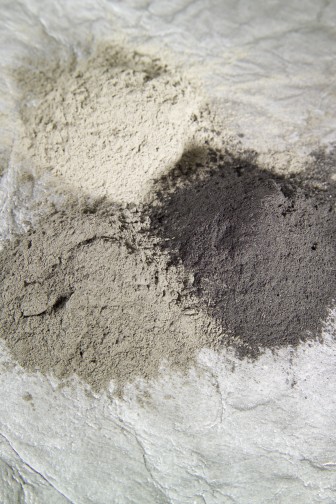Ruling Could Pollute Drinking Water State-Wide
EPA opens door to reuse of coal ash, despite evidence it's contaminating wells in Wisconsin.
Buried coal ash widespread

Frank Michna buys bottled water for drinking and cooking in his Caledonia home because of high levels of molybdenum and boron in his well. Photo by Cole Monka / Wisconsin Center for Investigative Journalism.
Before coal ash was regulated in Wisconsin, utilities legally dumped tons of the material in empty lots, waterways, landfills and other places.
Most of Madison’s Isthmus, between Lake Mendota and Lake Monona, is built upon coal ash from the Madison Gas & Electric Blount Street plant and other sources, such as Oscar Mayer. Ash lies under many parks and athletic fields and even beneath a St. Mary’s Hospital parking lot that was once a dump.
Though no molybdenum has been found in city wells, the metal chromium-6, also found in coal ash, has been discovered at low levels. Utility officials believe the metal is naturally occurring and not from ash.
Scott Reigstad, a spokesman for Alliant Energy, said about 83 percent of the more than 324,000 tons of coal ash produced by the company’s plants goes to beneficial reuse. Alliant’s subsidiary, Wisconsin Power & Light Co., operates plants in Columbia, Sheboygan and Grant counties.
Most of what was reused went into concrete and asphalt, which does not leach as easily into groundwater. The remaining 21,000 tons went toward mine reclamation, fill, soil stabilization and other uses.
About 17 percent of all the coal ash produced by the company in both Iowa and Wisconsin goes into landfills or coal ash ponds where the ash is stored as a sludge or slurry, Reigstad said.
The EPA has documented failures in coal ash storage, including the 140,000-ton February coal ash spill into North Carolina’s Dan River from an impoundment owned by Duke Energies.
In the mid-1990s, well tests near Alliant’s closed Nelson Dewey Ash Disposal facility revealed sulfate, boron, selenium, fluoride and arsenic.
Alliant’s two active Wisconsin landfills, one at the Edgewater plant near Sheboygan and the other at the Columbia plant near Portage, have liners and leachate collection systems. He added, however, that an older section of the Sheboygan pond remains unlined. He said groundwater monitoring near the landfills has not detected molybdenum at levels exceeding health standards.
Michna, whose contaminated well is not far from the We Energies Oak Creek plant, is wary of coal ash storage areas. He remembers the day in 2011 when 25,000 tons of ash collapsed from the company’s massive storage site on the shore of Lake Michigan. The company had filled a ravine with coal ash in the 1950s, before state regulations were passed.
DNR: More study beneficial
Despite the DNR’s critiques of the Clean Wisconsin report, Coakley said the agency would be especially interested in learning more about the connection of coal ash to molybdenum contamination. The issue, she said, is not likely to go away.
She added, however, that it is unlikely the agency will conduct those studies on its own because of its tight budget. The DNR is instead interested in collaborating with a research institution that can take the lead on such studies, Coakley added.
But Michna said it is beyond the time for studies.
Michna thought he was safe from contaminants after he sank a new 300-foot well in 2007 at his Racine County home. But several years later, he and his family started suffering from mysterious illnesses.
“My health went down and I got gout,” Michna said. “I had gout and I could hardly walk. I got special insoles.”
Michna also said he experienced gastrointestinal problems, which he believes may be connected to the boron in his water.
Boron showed up at 1,850 parts per billion, above the state enforcement standard of 1,000.
Molybdenum appeared at 27 ppb, below the state standard of 40.
Now, the Michnas buy five bottles of water a month for their drinking water. They installed a $3,000 filtered water softener.
Michna also said the assessed value of his new home has dropped from $385,000 to $270,000.
“This was supposed to be our paradise,” Michna said.
Ron Seely and Kate Golden are reporters for the Wisconsin Center for Investigative Journalism. Rachael Lallensack, Cole Monka and Daniel McKay are enrolled in one of eight journalism classes participating in The Confluence, a collaborative project involving the Center and UW-Madison School of Journalism and Mass Communication. The nonprofit Center (www.WisconsinWatch.org) collaborates with Wisconsin Public Radio, Wisconsin Public Television, other news media and the journalism school. All works created, published, posted or disseminated by the Center do not necessarily reflect the views or opinions of UW-Madison or any of its affiliates.
-
Wisconsin Lacks Clear System for Tracking Police Caught Lying
 May 9th, 2024 by Jacob Resneck
May 9th, 2024 by Jacob Resneck
-
Voters With Disabilities Demand Electronic Voting Option
 Apr 18th, 2024 by Alexander Shur
Apr 18th, 2024 by Alexander Shur
-
Few SNAP Recipients Reimbursed for Spoiled Food
 Apr 9th, 2024 by Addie Costello
Apr 9th, 2024 by Addie Costello























There may be many wells that have elevated levels of contaminants, but based on the maps provided in the article, there doesn’t appear to be a correlation between locations of Beneficial Reuse of coal ash and the wells that showed elevated levels of the contaminants. Plus you should at least display the maps at the same scale.
Yeah, I don’t want to rule out coal ash as a possible cause for these contaminated wells, but the correlation is weak at best. Where’s the map showing, say, historic fill sites in relation to contaminated wells? Or historic dumps? Or salvage yards? Or industrial facilities? Or, heck, at naturally occurring mineral deposits?
Now, I agree that more study should be performed. The lack of funding to the WDNR for this specific problem is a failure of government.
I’d argue not that we should do nothing, but that it’s premature to point the finger solely at coal ash.
I wouldn’t say it’s a failure of government, it’s a failure of politics. The job can be done by government but the voters aren’t holding the state government accountable for this.
We get what we deserve.
Politics or government, I agree that the voters need to make their voices heard on the issue. If I have well issues, I’m calling my government representative and make sure I get heard.
That said, repeating those maps above uncritically, does a disservice to a complicated issue. At the very least, you need to separate out the use of coal ash in concrete and asphalt, where it presumably doesn’t leach, from its use as a soil amendment. That’s a flat out basic error that calls into question the whole methodology of the study.
Really, to me it’s looks like they’re trying to fit the facts to a predetermined conclusion. It doesn’t mean they’re wrong, but correlation doesn’t equal causation and even the correlation is not conclusive. The starting point is the wells and an investigation tracing contamination back to a source, not trying to jump ahead and skip the investigation step.
I spent decades collecting well samples for analysis from around coal ash sites and other contaminated property locations. The map above shows there really is little correlation between the ash sites and well contamination problems. Sources could also be old leaky well linings that were never sealed properly and surface water runoff contaminates the well. The source could also be a background level.
There are many pre-1980 fill sites where materials were dumped to fill in a wetland and low area including along major waterways. The materials included foundry sand, incinerator ash, garbage, industrial liquid waste, etc. Milwaukee’s Menomonee Valley and Downtown area included over 1,000 acres of filled properties with humans’ waste debris with layers up to 20-30 feet deep. Many farms had there own private dump sites and allowed industry to fill things on their properties. Southeast Wisconsin was an industrial giant at one time and the buried waste pockets litter the country-side that could be potential sources of well contamination.
A lot more detailed investigation is needed. Regulated landfills are an easy target since we already know they are there but they have also been monitored and designed with best practices. All the unknown sites are really undiscovered and have no monitoring history or identification of the waste product.
Coal was in heavy use as the fuel of choice till the 1960s. Coal ash was spread on roads for de-icing before the start of salting, another toxic material. Homes also used coal for heating and ashes were likely spread on the property. During the 50s and 60s, you could smell the acrid odor of coal burning during the winter times and the snow would turn black with soot after a few days.